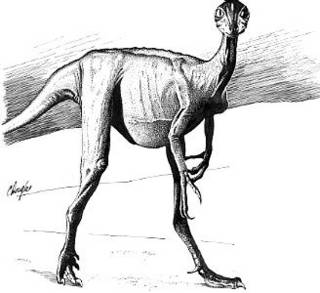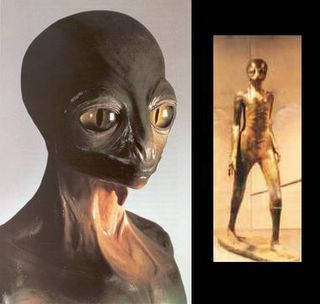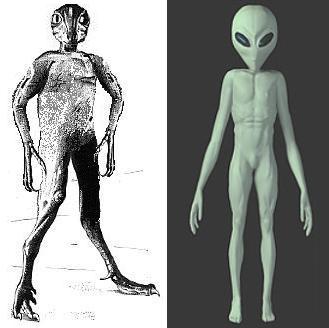
Imagine if you will, a warm blooded creature similar to Stenonychosaurus. Intelligent, and possessing the capacity for brain growth, with the physiology to adapt and learn from its environment. If such a creature like Stenonychosaurus had such an evolutionary advantage all those hundreds of millions of years ago, isn’t it remotely possible that such a creature did actually survive; and if it did survive, what would it look like today?
Dale Russell, discoverer of Stenonychosaurus, has postulated that late Cretaceous dinosaurs were well on the way to becoming highly intellectual animals, and would have succeeded if the dinosaurs had not suffered mass extinction. Russell deduced what the appearance of a Stenonychosaurus might look like, had it evolved unhampered by disasters until the 20th century (a model of the creature, a Dinosauroid, is on display at the Museum of Nature, Ottawa, Canada).
Russell believes their brain size would have been close to the human range. To accommodate it, its skull would have expanded and its face would have flattened. The long dinosaur neck would have shortened to bear more comfortably the weight of its brain. Consequently its tail would have been lost since it would not have been needed to counterpoise the neck and head.

Communication may have sounded similar to birdsong. Besides these conjectured features he supposes they would bear characteristics typical of dinosaurs such as scaly skin, large oval eyes with vertically slit pupils, absence of external sex organs and a three fingered hand, one digit of which would be opposable.
The illustration below and to the left was derived from the original depiction of Stenonychosaurus above. It has been modified inline with Russell’s proposition. Though the example here is crude to illustrate the point, you can see that the body posture has changed to become more upright, just as mans evolution has done much the same. Also the tail has become increasingly obsolete and removed.

Even with this very simple manipulation of the original illustration, I think you can begin to see a striking resemblance starting to emerge. Even the comparative limb length and hand shape are similarly proportionate.
Add to this picture the plausible theory that such a creature is highly intelligent, nocturnal, and possibly lives underground and you have a very real argument as to why this creature, or being, has not been found.
A number of animals and reptiles possess phenomenal camouflage techniques, such as the chameleon. Even if you happened to stumble across one of these beings in the dark, you would probably mistake it for a shadow or something else. The chances are that with its superior night vision and highly adapted nocturnal senses, it would see you long before you would ever see it. Even more so if it inhabited the more remote regions of the earth.
Ancient texts and religions are virtually teeming with stories about dragons and cunning serpents. Hebrew texts refer to the serpent of the garden of Eden as ‘Nachash’, which many Hebrew scholars contend was a bipedal or hominid reptile of great intelligence.
‘Nagas’ from ancient Indian mythology, are described as humanoid lizards or serpents.
The American Indians have a creation legend that says they came out of caves underground while the 'reptile people' were banished to underground.
‘Quetezecoatl’ was the feathered serpent of South American fame. He was a culture bearer and law giver. He is sometimes depicted flying on a rocket! He is described as a feathered serpent.
No comments:
Post a Comment